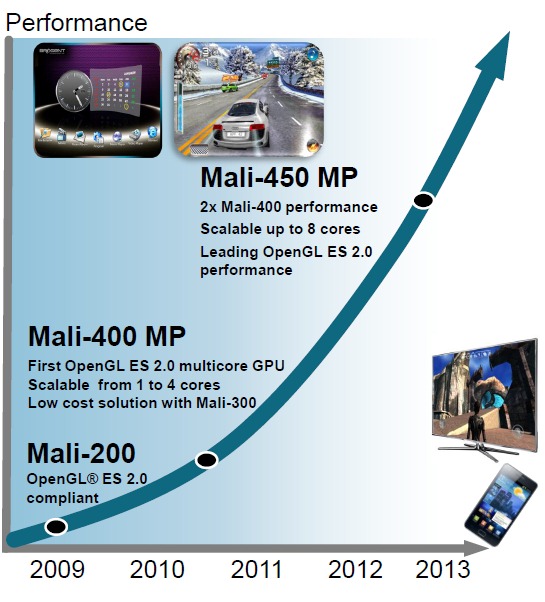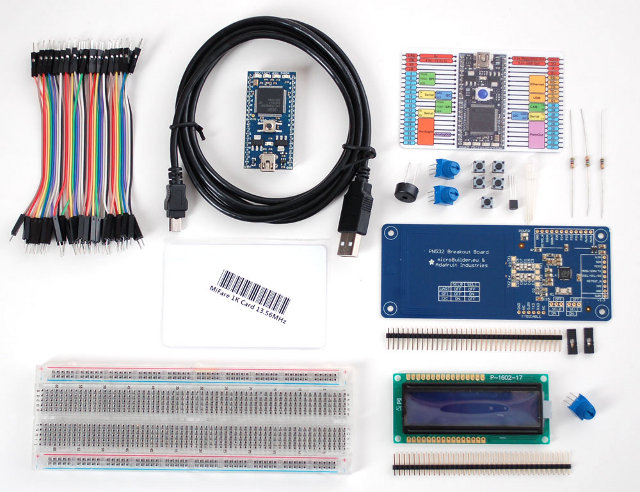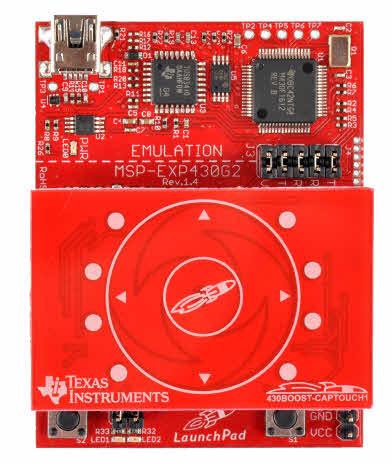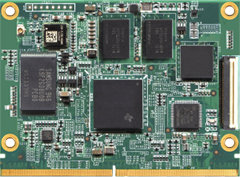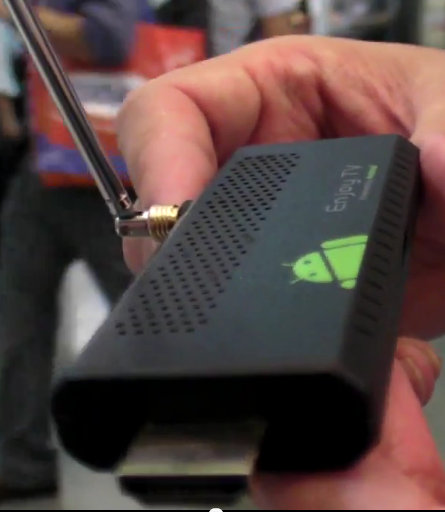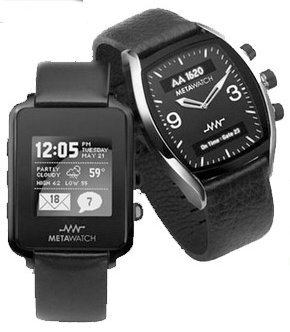EETimes reports that ARM has shown details about its new GPU, the Mali-T450, which offers up to twice the performance of the Mali-400 and can be scaled up to 8 cores, whereas Mali-400 can only be scaled up to 4 cores. The Mali-450 (codename Tyr) targets entry-level and mid-range mobile devices, and is said to be software compatible with Mali-400. ARM new GPU has also been “tweaked” to provide better performance at the cost of occupying a slightly larger area. The company recommends the use Mali-400 for 1 to 4 cores configuration and Mali-450 for 5 to 8 cores configuration for higher end products. Contrary to Mali-T604 and Mali-T685 GPU, Mali-450 does not support general purpose computing on GPU (GPGPU). ARM is also working on a new GPU codenamed Skrymir based on Midgard architecture (Like Mali-T604 & T658) that should be available in 2014. Source: EETimes Jean-Luc Aufranc (CNXSoft)Jean-Luc started […]
Adafruit mbed and NFC/RFID Starter Pack with µNFC stack & NFC Mood Lamp Demo
If you are looking for a (relatively) low cost NFC development kit, you may interested in Adafruit mbed and NFC/RFID Starter Pack that sells for 134.99 USD. The kit contains the following items: mbed LPC1768 (Cortex M3) development board with mini-B USB cable and reference cards NFC/RFID breakout board based on PN532 NFC transceiver MiFare RFID card with 1K programmable EEPROM Full-sized breadboard 40 x 3″ (75mm) long male/male jumper wires Standard blue & white 16×2 character LCD + contrast potentiometer + header Diffused 5mm RGB LED + 3 x 560 ohm resistors Analog temperature sensor (TMP36) Piezo buzzer 2 x 10K trim potentiometer 5 x Tactile Pushbuttons On the software side, you can use AppNearMe µNFC stack written in C++ that allows you to use a user interface on NFC-enabled smartphone, removing the need for knobs, buttons, screens on your embedded device. During the initial pairing, the NFC board can […]
Texas Instruments Launchpad MSP-EXP430G2 & Capacitive Touch Booster
This is a guest post about the low cost Launchpad MCU devkit. This kit was unveiled in 2010, but since I’d never written about this $4.30 development kit previously, I’ve accepted to publish the post below with slight modifications and amendments. You may be itching to get started with a micro-controller based project but held back because of the high cost of the development boards, and the complex nature of tools required. The good news is that Texas Instruments have come up with a development kit – including a board and the required development software tools. This tool is intended for beginners as well as experienced users. In fact, at under $5, the Texas Instruments’ LaunchPad gives you a complete environment in which you can get started with your projects. This LaunchPad Development Kit is a part of the Texas Instruments MSP430 Value Line series of micro-controllers. You can program, […]
TechNexion EDM Modules: Open Software and (somewhat) Open Hardware ARM & x86 CPU Modules
TechNexion, a Taiwanese “embedded solution” company, was present at Computex 2012 showcasing their ARM & x86 CPU Modules and corresponding development kits. The company recently created the EDM Standard, an open hardware and software standard for x86 and ARM Computer on Modules available under the creative commons share alike license. Their EDM modules come in three form factors: EDM Compact: 82 x 60 mm (ARM only) EDM Standard: 82 x 95 mm (ARM and x86) EDM Extended: 82 x 145 mm (x86 only) They have already designed 5 modules based on this standard: EDM-CF-iMX6 EDM Compact Module powered by Freescale i.MX6 (solo, dual or quad) EDM-CT-AM437x EDM Compact Module powered by TI Sitara AM437x (single core Cortex A9) EDM-SF-iMX6 EDM Standard Module with Freescale i.MX6 EDM-ST-AM437x EDM Standard Module with TI Sitara AM437x EDM-XI-QM77 EDM Extended Module with Intel QM77 3rd generation i3/i7 core I could not find information about […]
Geniatech Enjoy TV Stick ATV100: Amlogic AML8726-M3 Android 4.0 HDMI Dongle
Geniatech showcased the Enjoy TV Stick ATV100 at Computex 2012. This is yet another HDMI stick running Android 4.0, but instead of being powered by AllWinner A10 like most others, it is based on AMLogic AML8726-M3 (Single core Cortex A9) clocked at 800 MHz. The device also comes with 1 GB DDR3 memory, 2GB NAND Flash and features 2 USB ports (Standard USB 2.0 Host + mini USB OTG), a microSD slot and a port for an IR extension cable. Contrary to all HDMI dongles I have seen, there is also an external Wi-Fi antenna, as you can see on the picture above. An InfraRed remote with 6 keys is also included. The first part of the video below is about Geniatech ATV1200, an Android 4.0 set-top box based on AMLogic AML8726-MX (Dual Core Cortex A9), and the part about ATV100 starts at 2:23. I think there is a misunderstanding […]
Texas Instruments Wi-Fi Miracast Wireless Display on OMAP 4470
A few days ago, Texas Instruments announced a Wi-Fi CERTIFIED Miracast Video Streaming Solution based on OMAP4470 and WiLink 7.0, and they said in their press release that they would demo the platform at Computex 2012. Charbax is currently there, and shot a video showcasing different use cases possible with Miracast such as multi-tasking while streaming and mirroring. This technology looks very promising, especially since existing devices based on OMAP4470 will be able to support it with just a software update. You’ll also need to have a Miracast compliant TV, but eventually you should be able to buy a Miracast HDMI dongle for your TV (instead of buying a new TV), which is basically the board used in the demo except they use cables. This technology could be a threat to the MHL standard. The only advantage of the latter is that you don’t need power supply as it will […]
Texas Instruments Sells the MetaWatch, A Wearable Bluetooth 2.1 Watch Devkit For $139
I think there is a TI deal about once a month, and today Texas Instruments sells (via Digi-Key) a Pebble Watch clone device similar to Pebble Watch called MetaWatch which is based on TI MSP430 MCU and CC2560 Bluetooth host controller and was released last year. There are two models: Metawatch Analog ($139) Metawatch Digital ($149) Both models regular price is $203. The discounted price also includes free shipping, but you need to follow the instructions carefully. Although the Metawatch is supposed to currently support both Android and iOS, the model sold is the original one that only supports Android. Here are the specs of the digital Model: Compatibility: Most devices with Android OS 2.3 and up. Potentially any programmable device supporting Bluetooth 2.1 and up device with Serial Port Profile (SPP) connectivity. Case / strap: 3 ATM water resistant stainless steel, black or white replaceable genuine leather strap Display: Mirror polymer network […]
Mitac Unveils ARM Based GFX Server at Computex 2012
MiTAC International announced their first ARM server (MiTAC GFX) based on Marvell ARMADA XP SoC and running Ubuntu 12.04 LTS at Computex 2012, in Taipei. This solution appears to be similar to Dell “Copper” ARM server announced last week, which also uses Marvel ARMADA XP and runs Ubuntu 12.04, except its intended to be a real product rather than just a prototype. The MiTAC GFX with ASX-1 module is intended for deployment as a general purpose server where real estate, efficiency and throughput at a realistic price are key factors and typical applications include web hosting, web browsing, email, chat, social media and networking, etc. Later, MiTAC will introduce an ASX-HP (High Performance) module for compute intensive workloads that can be add to GFX system, and ASX modules featuring 64-bit SoC are under development. MiTAC showcased a GFX System with 64 nodes (that’s 256 Cortex A9 cores) at Computex 2012, […]


